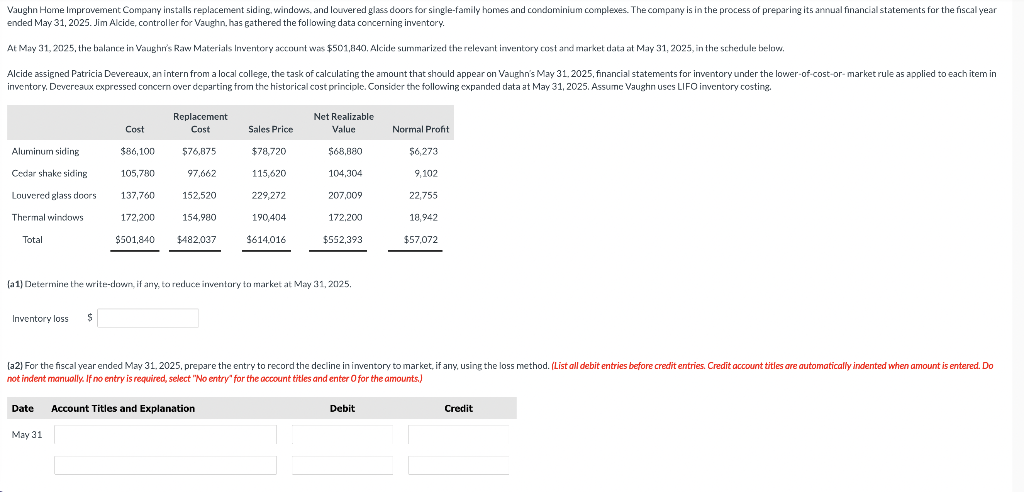(a1) Determine the write-down, if any, to reduce inventory to market at May 31, 2025. Inventory loss $ (a2) For the fiscal year ended May 31, 2025, prepare the entry to record the decline in inventory to market, if any, using the loss method. (List all debit entries before credit entries. Credit account titles are automatically indented when amount is entered. Do not indent manually. If no entry is required, select "No entry for the account titles and enter O for the amounts.)
(a1) Determine the write-down, if any, to reduce inventory to market at May 31, 2025. Inventory loss $ (a2) For the fiscal year ended May 31, 2025, prepare the entry to record the decline in inventory to market, if any, using the loss method. (List all debit entries before credit entries. Credit account titles are automatically indented when amount is entered. Do not indent manually. If no entry is required, select "No entry for the account titles and enter O for the amounts.)
College Accounting, Chapters 1-27
23rd Edition
ISBN:9781337794756
Author:HEINTZ, James A.
Publisher:HEINTZ, James A.
Chapter27: Adjustments, Financial Statements, And Year-end Accounting For A Manufacturing
business
Section: Chapter Questions
Problem 1MP: Reese Manufacturing Company manufactures and sells a limited line of products made to customer...
Related questions
Topic Video
Question
Ef 477.

Transcribed Image Text:Vaughn Home Improvement Company installs replacement siding, windows, and louvered glass doors for single-family homes and condominium complexes. The company is in the process of preparing its annual financial statements for the fiscal year
ended May 31, 2025. Jim Alcide, controller for Vaughn, has gathered the following data concerning inventory.
At May 31, 2025, the balance in Vaughn's Raw Materials Inventory account was $501,840. Alcide summarized the relevant inventory cost and market data at May 31, 2025, in the schedule below.
Alcide assigned Patricia Devereaux, an intern from a local college, the task of calculating the amount that should appear on Vaughn's May 31, 2025, financial statements for inventory under the lower-of-cost-or-market rule as applied to each item in
inventory. Devereaux expressed concern over departing from the historical cost principle. Consider the following expanded data at May 31, 2025. Assume Vaughn uses LIFO inventory costing.
Aluminum siding
Cedar shake siding
Louvered glass doors
Thermal windows
Total
Inventory loss
Cost
$
$86,100
May 31
105,780
137,760
172,200
$501,840
Replacement
Cost
$76,875
97,662
152,520
154,980
$482,037
Sales Price
$78,720
115,620
229,272
Date Account Titles and Explanation
190,404
$614,016
(a1) Determine the write-down, if any, to reduce inventory to market at May 31, 2025.
Net Realizable
Value
$68,880
104,304
207,009
172,200
$552,393
(a2) For the fiscal year ended May 31, 2025, prepare the entry to record the decline in inventory to market, if any, using the loss method. (List all debit entries before credit entries. Credit account titles are automatically indented when amount is entered. Do
not indent manually. If no entry is required, select "No entry for the account titles and enter O for the amounts.)
Normal Profit
Debit
$6,273
9,102
22,755
18,942
$57,072
Credit
Expert Solution
This question has been solved!
Explore an expertly crafted, step-by-step solution for a thorough understanding of key concepts.
This is a popular solution!
Trending now
This is a popular solution!
Step by step
Solved in 2 steps

Knowledge Booster
Learn more about
Need a deep-dive on the concept behind this application? Look no further. Learn more about this topic, accounting and related others by exploring similar questions and additional content below.Recommended textbooks for you

College Accounting, Chapters 1-27
Accounting
ISBN:
9781337794756
Author:
HEINTZ, James A.
Publisher:
Cengage Learning,

Financial Accounting
Accounting
ISBN:
9781337272124
Author:
Carl Warren, James M. Reeve, Jonathan Duchac
Publisher:
Cengage Learning

Principles of Cost Accounting
Accounting
ISBN:
9781305087408
Author:
Edward J. Vanderbeck, Maria R. Mitchell
Publisher:
Cengage Learning

College Accounting, Chapters 1-27
Accounting
ISBN:
9781337794756
Author:
HEINTZ, James A.
Publisher:
Cengage Learning,

Financial Accounting
Accounting
ISBN:
9781337272124
Author:
Carl Warren, James M. Reeve, Jonathan Duchac
Publisher:
Cengage Learning

Principles of Cost Accounting
Accounting
ISBN:
9781305087408
Author:
Edward J. Vanderbeck, Maria R. Mitchell
Publisher:
Cengage Learning


Cornerstones of Cost Management (Cornerstones Ser…
Accounting
ISBN:
9781305970663
Author:
Don R. Hansen, Maryanne M. Mowen
Publisher:
Cengage Learning

Individual Income Taxes
Accounting
ISBN:
9780357109731
Author:
Hoffman
Publisher:
CENGAGE LEARNING - CONSIGNMENT